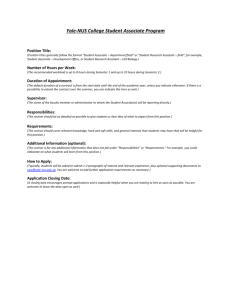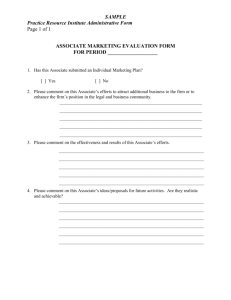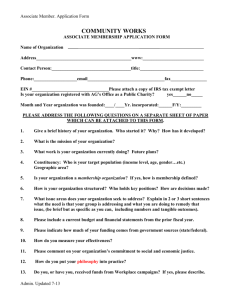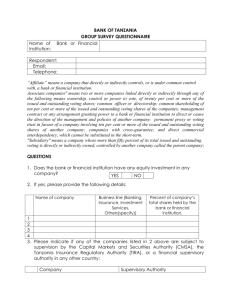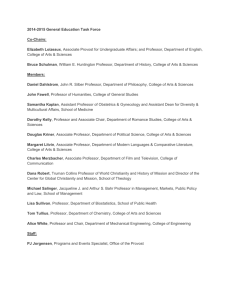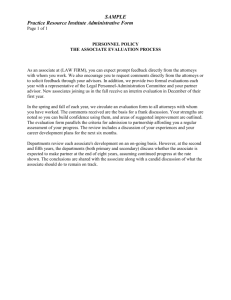Amendments to IFRS 10 and IAS 28 September 2014
advertisement
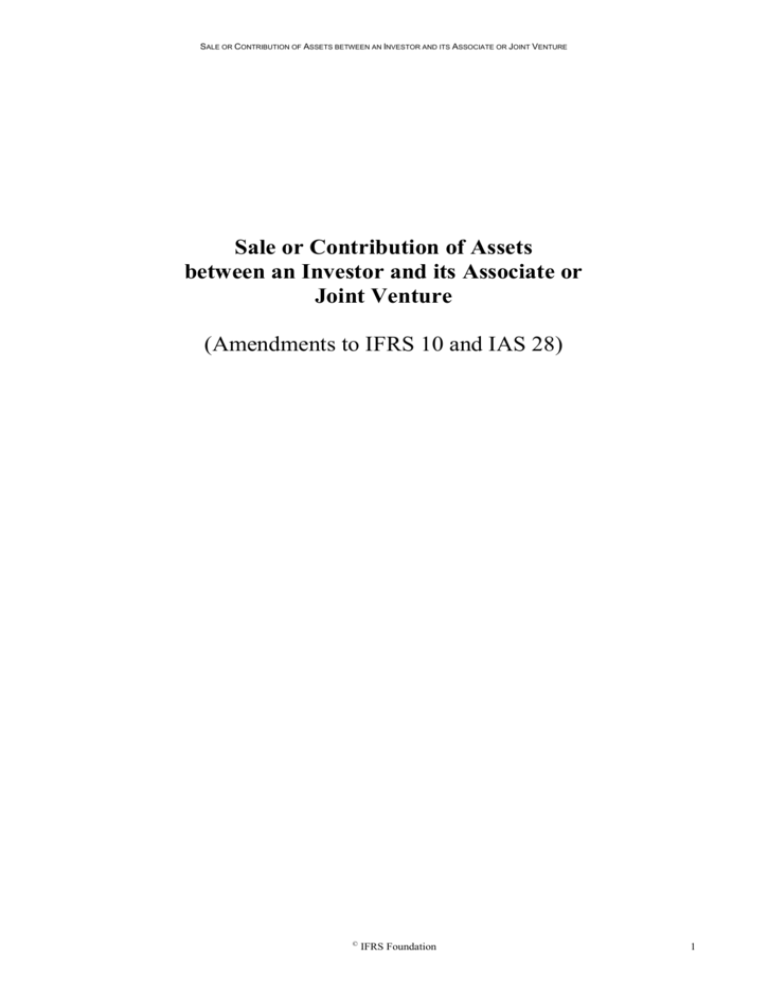
SALE OR CONTRIBUTION OF ASSETS BETWEEN AN INVESTOR AND ITS ASSOCIATE OR JOINT VENTURE Sale or Contribution of Assets between an Investor and its Associate or Joint Venture (Amendments to IFRS 10 and IAS 28) © IFRS Foundation 1 AMENDMENTS TO IFRS 10 AND IAS 28—SEPTEMBER 2014 Amendments to IFRS 10 Consolidated Financial Statements Paragraphs 25–26 are amended. Deleted text is struck through and new text is underlined. Loss of control 25 26 If a parent loses control of a subsidiary, the parent: (a) derecognises the assets and liabilities of the former subsidiary from the consolidated statement of financial position. (b) recognises any investment retained in the former subsidiary at its fair value when control is lost and subsequently accounts for it and for any amounts owed by or to the former subsidiary in accordance with relevant IFRSs. That fair value retained interest is remeasured, as described in paragraphs B98(b)(iii) and B99A. The remeasured value at the date that control is lost shall be regarded as the fair value on initial recognition of a financial asset in accordance with IFRS 9 or the cost on initial recognition of an investment in an associate or joint venture, if applicable. (c) recognises the gain or loss associated with the loss of control attributable to the former controlling interest, as specified in paragraphs B98–B99A. Paragraphs B97–B99A set out guidance for the accounting for the loss of control of a subsidiary. In Appendix B, paragraph B99A is added. New text is underlined. Loss of control ... B99A 2 If a parent loses control of a subsidiary that does not contain a business, as defined in IFRS 3, as a result of a transaction involving an associate or a joint venture that is accounted for using the equity method, the parent determines the gain or loss in accordance with paragraphs B98–B99. The gain or loss resulting from the transaction (including the amounts previously recognised in other comprehensive income that would be reclassified to profit or loss in accordance with paragraph B99) is recognised in the parent’s profit or loss only to the extent of the unrelated investors’ interests in that associate or joint venture. The remaining part of the gain is eliminated against the carrying amount of the investment in that associate or joint venture. In addition, if the parent retains an investment in the former subsidiary and the former subsidiary is now an associate or a joint venture that is accounted for using the equity method, the parent recognises the part of the gain or loss resulting from the remeasurement at fair value of the investment retained in that former subsidiary in its profit or loss only to the extent of the unrelated investors’ interests in the new associate or joint venture. The remaining part of that gain is eliminated against the carrying amount of the investment retained in the former subsidiary. If the parent retains an investment in the former subsidiary that is now accounted for in accordance with IFRS 9, the part of the gain or loss resulting from the remeasurement at fair value of the investment retained in the former subsidiary is recognised in full in the parent’s profit or loss. © IFRS Foundation SALE OR CONTRIBUTION OF ASSETS BETWEEN AN INVESTOR AND ITS ASSOCIATE OR JOINT VENTURE Application examples Example 17 A parent has a 100 per cent interest in a subsidiary that does not contain a business. The parent sells 70 per cent of its interest in the subsidiary to an associate in which it has a 20 per cent interest. As a consequence of this transaction the parent loses control of the subsidiary. The carrying amount of the net assets of the subsidiary is CU100 and the carrying amount of the interest sold is CU70 (CU70 = CU100 × 70%). The fair value of the consideration received is CU210, which is also the fair value of the interest sold. The investment retained in the former subsidiary is an associate accounted for using the equity method and its fair value is CU90. The gain determined in accordance with paragraphs B98–B99, before the elimination required by paragraph B99A, is CU200 (CU200 = CU210 + CU90 – CU100). This gain comprises two parts: (a) the gain (CU140) resulting from the sale of the 70 per cent interest in the subsidiary to the associate. This gain is the difference between the fair value of the consideration received (CU210) and the carrying amount of the interest sold (CU70). According to paragraph B99A, the parent recognises in its profit or loss the amount of the gain attributable to the unrelated investors’ interests in the existing associate. This is 80 per cent of this gain, that is CU112 (CU112 = CU140 × 80%). The remaining 20 per cent of the gain (CU28 = CU140 × 20%) is eliminated against the carrying amount of the investment in the existing associate. (b) the gain (CU60) resulting from the remeasurement at fair value of the investment directly retained in the former subsidiary. This gain is the difference between the fair value of the investment retained in the former subsidiary (CU90) and 30 per cent of the carrying amount of the net assets of the subsidiary (CU30 = CU100 × 30%). According to paragraph B99A, the parent recognises in its profit or loss the amount of the gain attributable to the unrelated investors’ interests in the new associate. This is 56 per cent (70% × 80%) of the gain, that is CU34 (CU34 = CU60 × 56%). The remaining 44 per cent of the gain CU26 (CU26 = CU60 × 44%) is eliminated against the carrying amount of the investment retained in the former subsidiary. In Appendix C, paragraph C1C is added. New text is underlined. Effective date ... C1C Sale or Contribution of Assets between an Investor and its Associate or Joint Venture (Amendments to IFRS 10 and IAS 28), issued in September 2014, amended paragraphs 25–26 and added paragraph B99A. An entity shall apply those amendments prospectively to transactions occurring in annual periods beginning on or after 1 January 2016. Earlier application is permitted. If an entity applies those amendments earlier, it shall disclose that fact. © IFRS Foundation 3 AMENDMENTS TO IFRS 10 AND IAS 28—SEPTEMBER 2014 Amendments to IAS 28 Investments in Associates and Joint Ventures Paragraphs 28 and 30 are amended and paragraphs 31A–31B and 45C are added. Deleted text is struck through and new text is underlined. Paragraphs 29 and 31 are reproduced for ease of reference, but are not amended. Equity method procedures ... 28 Gains and losses resulting from ‘upstream’ and ‘downstream’ transactions involving assets that do not constitute a business, as defined in IFRS 3, between an entity (including its consolidated subsidiaries) and its associate or joint venture are recognised in the entity’s financial statements only to the extent of unrelated investors’ interests in the associate or joint venture. ‘Upstream’ transactions are, for example, sales of assets from an associate or a joint venture to the investor. The entity’s share in the associate’s or the joint venture’s gains or losses resulting from these transactions is eliminated. ‘Downstream’ transactions are, for example, sales or contributions of assets from the investor to its associate or its joint venture. The investor’s share in the associate’s or joint venture’s gains or losses resulting from these transactions is eliminated. 29 When downstream transactions provide evidence of a reduction in the net realisable value of the assets to be sold or contributed, or of an impairment loss of those assets, those losses shall be recognised in full by the investor. When upstream transactions provide evidence of a reduction in the net realisable value of the assets to be purchased or of an impairment loss of those assets, the investor shall recognise its share in those losses. 30 The gain or loss resulting from the contribution of a non-monetary assets that do not constitute a business, as defined in IFRS 3, to an associate or a joint venture in exchange for an equity interest in the that associate or joint venture shall be accounted for in accordance with paragraph 28, except when the contribution lacks commercial substance, as that term is described in IAS 16 Property, Plant and Equipment. If such a contribution lacks commercial substance, the gain or loss is regarded as unrealised and is not recognised unless paragraph 31 also applies. Such unrealised gains and losses shall be eliminated against the investment accounted for using the equity method and shall not be presented as deferred gains or losses in the entity’s consolidated statement of financial position or in the entity’s statement of financial position in which investments are accounted for using the equity method. 31 If, in addition to receiving an equity interest in an associate or a joint venture, an entity receives monetary or non-monetary assets, the entity recognises in full in profit or loss the portion of the gain or loss on the non-monetary contribution relating to the monetary or non-monetary assets received. 31A The gain or loss resulting from a downstream transaction involving assets that constitute a business, as defined in IFRS 3, between an entity (including its consolidated subsidiaries) and its associate or joint venture is recognised in full in the investor’s financial statements. 31B An entity might sell or contribute assets in two or more arrangements (transactions). When determining whether assets that are sold or contributed constitute a business, as defined in IFRS 3, an entity shall consider whether the sale or contribution of those assets is part of multiple arrangements that should be accounted for as a single transaction in accordance with the requirements in paragraph B97 of IFRS 10. … Effective date and transition ... 45C 4 Sale or Contribution of Assets between an Investor and its Associate or Joint Venture (Amendments to IFRS 10 and IAS 28), issued in September 2014, amended paragraphs 28 and 30 and added paragraphs 31A–31B. An entity shall apply those amendments prospectively to the sale or contribution of assets © IFRS Foundation SALE OR CONTRIBUTION OF ASSETS BETWEEN AN INVESTOR AND ITS ASSOCIATE OR JOINT VENTURE occurring in annual periods beginning on or after 1 January 2016. Earlier application is permitted. If an entity applies those amendments earlier, it shall disclose that fact. © IFRS Foundation 5
